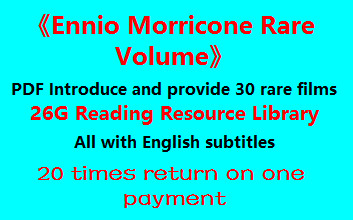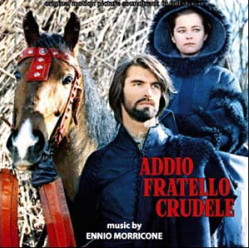ADDIO FRATELLO CRUDELI (1971)
Addio Fratello Crudeli is an Italian romantic drama directed by Giuseppe Patroni Griffi, based on the controversial 1629 play ‘Tis Pity She’s a Whore by the renaissance-era English author John Ford. The film stars Olivier Tobias as Giovanni, the son of a wealthy Italian nobleman, who is sent away to study overseas. When he returns many years later he meets and falls in love with a beautiful young woman named Annabella (Charlotte Rampling) – only to discover that she is his younger sister, who was only a small child when he left. Despite everything the pair embark on an incestuous relationship, the shame of which is only compounded when Annabella becomes pregnant.
Morricone’s score for the film offers no judgement on the central characters, and treats the relationship as a traditional romance; as such, his main theme for the pair in “Giovanni e Annabella” is one of his loveliest, a hauntingly beautiful melody for strings and woodwinds accompanied by a classic Morricone harpsichord to give it a historical renaissance sound. It is twinged with a little melancholy – as if foreshadowing the doomed fate of the lovers – but is one of the composer’s most traditionally appealing love themes of the period. The theme appears frequently throughout the score, notably in “In Fondo al Pozzo” where it is rendered as a trio for church organ, guitar, and voices, the lush and dramatic “Amami o Uccidimi,” the bucolic “Soranzo,” and the sublime “La Gioia,” which picks up a dramatic rhythmic undercurrent in its second half.
Other cues of note include the two “Frate Boneventura” cues, a pair of peacefully spiritual sequences for soft voices, flutes, gently lilting strings, and renaissance era dulcimers, the former of which features a lovely passage of hypnotic overlapping layered strings that foreshadows some of the writing in The Mission. “Il Mio Mondo Con Lei Era Perfetto” is a gorgeous duet for recorder and guitar, perfectly redolent of the time period. “Le Prime Ombre,” “Sospensione Prima,” and “Sospensione Seconda” are starker and more dissonant, both featuring sharp stinging string figures, nervous stabs from the harpsichord, and unsettling percussive ideas; “Sveglia Nel Castello” is their exact opposite, a jovial period dance.
Of course, stories such as these never end well for star-crossed lovers, and the conclusive cues are underpinned with romantic tragedy and the kiss of death. Both “Rivedendola” and “La Morte di Annabella” reprise the main theme with an appropriate sense of elegiac beauty, while “Inter Mortuous Liber (Dies Irae)” uses deep and resonant male voiced Latin chanting to end the score on a funereal note.
Addio Fratello Crudeli, while still containing its fair share of dissonance and period orchestration, is nevertheless one of Morricone’s loveliest scores of the period, being anchored by one of his most tragically beautiful main themes. The score has been released multiple times over the years; the one reviewed here is the one released by Italian label Digitmovies in 2006.
Track Listing: 1. Giovanni E Annabella (2:25), 2. Frate Bonaventura (9:25), 3. Il Mio Mondo Con Lei Era Perfetto (3:26), 4. Le Prime Ombre (1:42), 5. In Fondo al Pozzo (2:36), 6. Amami o Uccidimi (4:58), 7. Sospensione Prima (7:45), 8. Soranzo (3:50), 9. La Gioia (2:35), 10. Sveglia Nel Castello (4:11), 11. Frate Bonaventura (6:45), 12. Non Chiamarmi Piu Fratello, Chiamami Amore (3:59), 13. Sospensione Seconda (9:09), 14. Rivedendola (0:56), 15. La Morte di Annabella (1:10), 16. Inter Mortuous Liber (Dies Irae) (2:14). Digitmovies CDDM-065, 67 minutes 06 seconds.












